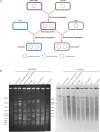Prevalence of hypervirulent and carbapenem-resistant Klebsiella pneumoniae under divergent evolutionary patterns
- PMID: 35844192
- PMCID: PMC9359173
- DOI: 10.1080/22221751.2022.2103454
Prevalence of hypervirulent and carbapenem-resistant Klebsiella pneumoniae under divergent evolutionary patterns
Abstract
K1/K2 hvKP strains acquire carbapenem-resistance plasmids, known as CR-hvKp, and carbapenem-resistant Klebsiella pneumoniae (CRKP) strains obtain virulence plasmids, recognized as hv-CRKP. The two different evolution patterns of hypervirulent combined carbapenem-resistant Klebsiella pneumoniae may lead to their different prevalence in hospitals. Our study aimed to investigate the prevalence of hv-CRKP and CR-hvKp strains and to analyze factors influencing their evolution and prevalence. We collected 890 K. pneumoniae genomes from GenBank and 530 clinical K. pneumoniae isolates from nine hospitals. Our study found that hv-CRKP strains were more prevalent than CR-hvKp strains and both were dominated by blaKPC-2 gene. The blaKPC-2-carrying plasmids could mobilize non-conjugative virulence plasmids from hvKp strains to CRKP strains. The conserved oriT of virulence plasmids and the widespread of conjugative helper plasmids were potential factors for the mobilization of non-conjugative virulence plasmids. HvKp strains with KPC plasmid could hardly simultaneously exhibit hypervirulence and carbapenem resistance as CRKP strains with virulence plasmid, and we found that rfaH mutation reduced capsular synthesis and increased carbapenem resistance of the CR-hvKp strain. In summary, this study revealed that hv-CRKP strains were more suitable for survival in hospital settings than CR-hvKp strains and the widespread conjugative KPC-producing plasmids contributed to the emergence and prevalence of hv-CRKP strains.
Keywords: Hypervirulent; carbapenem resistance; conjugation; genome evolution; oriT.
Conflict of interest statement
No potential conflict of interest was reported by the author(s).
Figures






Similar articles
-
Characterization difference of typical KL1, KL2 and ST11-KL64 hypervirulent and carbapenem-resistant Klebsiella pneumoniae.Drug Resist Updat. 2023 Mar;67:100918. doi: 10.1016/j.drup.2023.100918. Epub 2023 Jan 3. Drug Resist Updat. 2023. PMID: 36610180
-
Epidemiological, phenotypic and genotypic characteristics difference of hypervirulent and carbapenem-resistant Klebsiella pneumoniae with different capsular serotypes.J Microbiol Immunol Infect. 2025 Aug;58(4):444-454. doi: 10.1016/j.jmii.2025.02.010. Epub 2025 Feb 28. J Microbiol Immunol Infect. 2025. PMID: 40055131
-
Emergence of hypervirulent and carbapenem-resistant Klebsiella pneumoniae from 2014 - 2021 in Central and Eastern China: a molecular, biological, and epidemiological study.BMC Microbiol. 2024 Nov 11;24(1):465. doi: 10.1186/s12866-024-03614-9. BMC Microbiol. 2024. PMID: 39528921 Free PMC article.
-
The mechanisms of resistance, epidemiological characteristics, and molecular evolution of carbapenem-resistant hypervirulent Klebsiella pneumoniae.Lab Med. 2025 Jul 11;56(4):323-335. doi: 10.1093/labmed/lmae110. Lab Med. 2025. PMID: 40072365 Review.
-
Hypervirulent and carbapenem-resistant Klebsiella pneumoniae: A global public health threat.Microbiol Res. 2024 Nov;288:127839. doi: 10.1016/j.micres.2024.127839. Epub 2024 Aug 11. Microbiol Res. 2024. PMID: 39141971 Review.
Cited by
-
Clinical Characteristics and Molecular Epidemiology of ST23 Klebsiella pneumoniae in China.Infect Drug Resist. 2023 Dec 11;16:7597-7611. doi: 10.2147/IDR.S428067. eCollection 2023. Infect Drug Resist. 2023. PMID: 38107431 Free PMC article.
-
Genomic Epidemiology and Characterization of Carbapenem-Resistant Klebsiella pneumoniae in ICU Inpatients in Henan Province, China: a Multicenter Cross-Sectional Study.Microbiol Spectr. 2023 Jun 15;11(3):e0419722. doi: 10.1128/spectrum.04197-22. Epub 2023 May 22. Microbiol Spectr. 2023. PMID: 37212684 Free PMC article.
-
Characterization and genomic insights into bacteriophages Kpph1 and Kpph9 against hypervirulent carbapenem-resistant Klebsiella pneumoniae.Virulence. 2025 Dec;16(1):2450462. doi: 10.1080/21505594.2025.2450462. Epub 2025 Jan 13. Virulence. 2025. PMID: 39803864 Free PMC article.
-
Case of blaKPC-12 -carrying hypervirulent Klebsiella pneumoniae from bloodstream infection in China.JAC Antimicrob Resist. 2025 Apr 5;7(2):dlaf048. doi: 10.1093/jacamr/dlaf048. eCollection 2025 Apr. JAC Antimicrob Resist. 2025. PMID: 40191059 Free PMC article. No abstract available.
-
Genomic characteristics and phylogenetic analyses of colonization and infection with carbapenem-resistant Klebsiella pneumoniae in multicenter intensive care units: a cohort study.Microbiol Spectr. 2025 Apr;13(4):e0158424. doi: 10.1128/spectrum.01584-24. Epub 2025 Feb 24. Microbiol Spectr. 2025. PMID: 39992107 Free PMC article.
References
-
- Siu LK, Yeh KM, Lin JC, et al. . Klebsiella pneumoniae liver abscess: a new invasive syndrome. Lancet Infect Dis. 2012;12(11):881–887. - PubMed
-
- Nordmann P, Cuzon G, Naas T.. The real threat of Klebsiella pneumoniae carbapenemase-producing bacteria. Lancet Infect Dis. 2009;9(4):228–236. - PubMed
-
- Gu D, Dong N, Zheng Z, et al. . A fatal outbreak of ST11 carbapenem-resistant hypervirulent Klebsiella pneumoniae in a Chinese hospital: a molecular epidemiological study. Lancet Infect Dis. 2018;18(1):37–46. - PubMed
MeSH terms
Substances
LinkOut - more resources
Full Text Sources
Other Literature Sources
